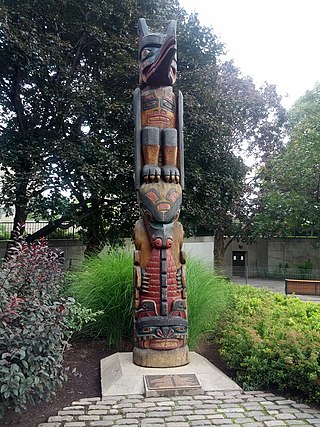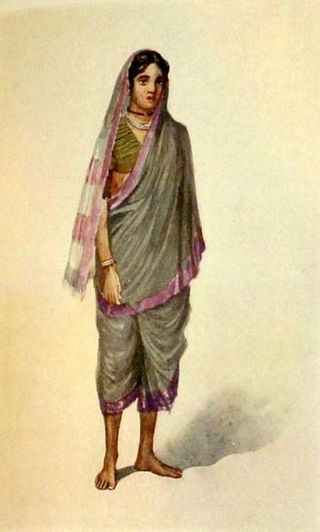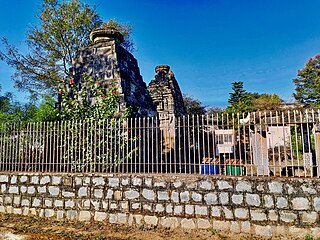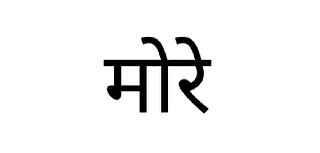
A totem is a spirit being, sacred object, or symbol that serves as an emblem of a group of people, such as a family, clan, lineage, or tribe, such as in the Anishinaabe clan system.

The Maratha Empire was an early modern Indian empire and later a confederation that controlled large portions of the Indian subcontinent in the 18th century. Maratha rule formally began in 1674 with the coronation of Shivaji of the Bhonsle dynasty as the Chhatrapati. Although Shivaji came from the Maratha caste, the Maratha empire also included warriors, administrators, and other nobles from the Maratha and several other castes from what is known today as Maharashtra. The Maratha Kingdom was expanded into a full-fledged Empire in the 18th Century under the leadership of Peshwa Bajirao I.
The Maratha caste is composed of 96 clans, originally formed in the earlier centuries from the amalgamation of families from the peasant (Kunbi), shepherd (Dhangar), blacksmith (Lohar), carpenter (Sutar), Bhandari, Thakar and Koli castes in Maharashtra. Many of them took to military service in the 16th century for the Deccan sultanates or the Mughals. Later in the 17th and 18th centuries, they served in the armies of the Maratha Empire, founded by Shivaji, a Maratha Kunbi by caste. Many Marathas were granted hereditary fiefs by the Sultanates, and Mughals for their service.
Bhagat is a term used in the Indian subcontinent to describe religious personalities who have obtain high acclaim in their community for their services and devoutness. It is also one of the clan in Mahar caste with clan totem as King Cobra and also a surname found among Marathas, Bania communities and Punjabi Brahmins.

Peshwa was second highest office in the Maratha Confederacy, next in rank and prestige only to that of the Chhatrapati. Initially serving as the appointed prime minister in the Maratha empire, the office became hereditary after the death of Shahu in 1749. During the reign of Shahu, the office of Peshwa grew in power and the Peshwas came to be the de facto rulers of the Maratha empire. However following the defeat of the Marathas in 1761, the office of the Peshwa became titular as well and from that point onwards served as the ceremonial head of the Confederacy underneath the Chhatrapati.

Chhatrapati is a royal title from Sanskrit used to denote a monarch or imperial head of state. The word "Chhatrapati" is a Sanskrit language compound word of chhatra and pati (master/lord/ruler). This title was used by the House of Bhonsle, between 1674 and 1818, as the heads of state of the Maratha Confederacy.

Kunbi is a generic term applied to several castes of traditional farmers in Western India. These include the Dhonoje, Ghatole, Masaram, Hindre, Jadav, Jhare, Khaire, Lewa, Lonare and Tirole communities of Vidarbha. The communities are largely found in the state of Maharashtra but also exist in the states of Madhya Pradesh, Gujarat, Karnataka, Kerala and Goa. Kunbis are included among the Other Backward Classes (OBC) in Maharashtra.

Mahar is an Indian caste found largely in the state of Maharashtra and neighbouring areas. Most of the Mahar community followed B. R. Ambedkar in converting to Buddhism in the middle of the 20th century. There are still some Mahars who practice Hinduism.

Saharanpur district is the northernmost of the districts of Uttar Pradesh state, India. Bordering the states of Haryana, Himachal Pradesh and Uttarakhand, and close to the foothills of Shivalik range, it lies in the northern part of the Doab region. It is primarily an agricultural area.

Balaghat district is a district of Madhya Pradesh state in Central India.
The Maratha Clan System, refers to the 96 Maratha clans.The clans together form the Maratha caste of India. These Marathas primarily reside in the Indian state of Maharashtra, with smaller regional populations in other states.
Mulher is a village in the Nashik district of Maharashtra, India.
Talegaon is a town on the outskirts of the city of Pune, India.
Vijaypur is a town, tehsil and municipal committee, nearby Samba town, Jammu city and a notified area committee in Samba district in the Indian union territory of Jammu and Kashmir, situated on the bank of Devak River, known locally as Gupt Ganga. It is one of the most fast-growing towns near Jammu. With AIIMS being developed in the town, it can see more influx of people around the Jammu, Samba and Kathua districts.the name of Vijaypur is derived from brij dev singh and he was belonged to Jammoria family
Bhoite is a surname found amongst the Maratha caste, mainly in the state of Maharashtra in India but it also appears in Indian states bordering Maharashtra.
Panch Pallava is a ritual assortment of five different leaves used as a devak (totem) by the Maratha culture in India.

Morè is the name of a Maratha clan as well as a Mahar clan from the state of Maharashtra. Members of the More Maratha clan as well as the Mahar clan use the clan name as their surname. The totem associated with the clan is a peacock. Members of the Mahar clan worshipping the same Totem cannot intermarry.
Harpale (हरपळे) is a surname used by Indian Maratha community. The name is legendary among Maratha Royalties. They were honoured as Sardar, Patil and Deshmukh. They have a Royal Mark of Gaikwad Maharajas of Baroda. They possess Deshmukh rights of villages in Nagpur. Their relations are associated with the prominent Maratha clan of 96 Royal Clans.
Originally Chavhan which is written as Chavan by some people is a clan mostly found in Koli, Maratha and Banjara found largely in Maharashtra, India, and neighbouring states.
Kunjir are descent from one branch of the Seuna Yadavas of Devagiri, which is Maratha Kshatriya. In the 13th century, Seuna Yadavas of Devagiri's King Singhan II marched towards the near-eastern part of Pune, to protect his provenance from the attacks of North. He won as well as lost few wars. Some of his sardars decided stay behind. They settled near Baramati, Bhuleshwar, Shindavane, Dhawaleshwar & Kanifnath Temples, near the eastern part of Pune and ruled the winning area as Patil. Some of them were leading the war elephantry section of the army at that era. In Sanskrit, "elephant" is pronounced as a "Kunj" (कुंज), so this branch was known as "Koonjur" (कुंजर), which was later on inherited as "Kunjir" (कुंजीर). Kunjir's current residency is located in the Village Waghapur in Purandhar Taluka from Pune District. This surname is commonly found in the maratha kshatriya peoples.









